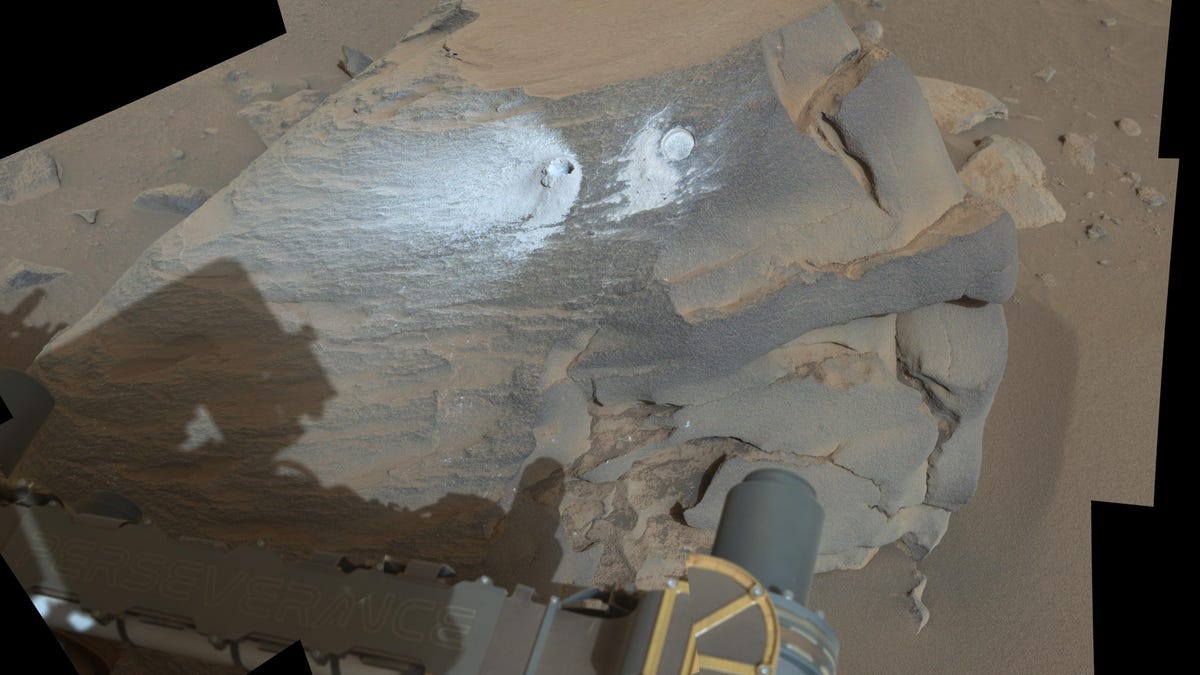Unlike its predecessor, Curiosity, NASA’s Perseverance rover is expressly designed to “search for potential evidence of past life,” according to the study official mission objectives.
Crater lake The site was chosen as a landing site primarily because it contains remnants of ancient mud and other sediments deposited where a river flowed into a lake more than three billion years ago. We don’t know if there was life in this lake, but if so, Perseverance could find evidence of it.
We can imagine Perseverance encountering large, well-preserved fossils of microbial colonies – perhaps similar the coal-like “stromatolites” that solar-powered bacteria were produced along ancient coastlines on Earth. Fossils like these would be large enough to be seen clearly with the rover’s cameras and could also contain chemical evidence of ancient life the rover’s spectroscopic instruments could recognize.
But even in such wildly optimistic scenarios, we wouldn’t be entirely sure we’d found fossils until we could look at them under microscopes in laboratories on Earth. That’s because this is possible for geological features made through non-biological processes to resemble fossils. These are called pseudofossils. That’s why Perseverance not only looks for fossils on site, but also collects samples. If all goes well, about 30 specimens will be returned to Earth as part of a follow-up mission planned in collaboration with the European Space Agency (ESA).
Earlier this month, NASA announced that a particularly interesting specimen, the 24th for Perseverance and informally dubbed “Comet Geyser,” had been added to the rover’s growing collection. This comes from an outcrop called Bunsen Peak, which is part of a rocky deposit called the Margin Unit, located near the crater rim.
This rock unit may have formed over time the shore of the old lake. Rover instruments have shown that the Bunsen Peak sample is composed predominantly of carbonate minerals (the main component of rocks such as limestone, chalk and travertine on Earth).
The small carbonate grains are cemented with pure silicon dioxide (similar to opal or quartz). NASA press release quotes Ken Farley, Perseverance project scientist, as saying, “This is the type of rock we were hoping to find when we decided to study Jezero Crater.”
But what is so special about carbonates? And what makes the Bunsen Peak sample particularly exciting from the perspective of astrobiology, the study of life in the universe? Well, first, this rock could have formed under conditions we would recognize as habitable: capable of supporting the metabolism of life as we know it.
One factor affecting habitability is the availability of water. Both carbonate and silicate minerals can form by direct precipitation from liquid water. Sample 24 may have precipitated from lake water at temperatures and chemical conditions consistent with life, although there may be other possibilities that need to be tested. In fact, carbonate minerals are surprisingly rare on Mars because carbon dioxide has always been abundant there.
In the wet environments of early Mars, this CO₂ should have dissolved in water and reacted to form carbonate minerals. Analysis of the Bunsen peak and Sample 24 when sent to Earth could eventually help us solve this mystery. One side of the outcrop has some interesting rough and streaky textures that could clarify its origin, but they are difficult to interpret without further data.
Second, we know from examples on Earth that ancient sedimentary carbonates can produce wonderful fossils. These fossils include stromatolites, which are composed of carbonate crystals precipitated directly by bacteria. Perseverance has not seen any convincing examples of this.
There are some there concentric circular patterns in the marginal unit, but they are almost certainly an effect of weathering. But even where there are no stromatolites, some ancient carbonates on Earth contain fossilized colonies of microbial cells that form ghostly sculptures in which the original cellular structures have been replaced by minerals.
The small grain size of the “Comet Geyser” sample indicates a higher potential for preserving delicate fossils. Under certain conditions, fine-grained carbonates can even retain organic matter – the modified remains of fats, pigments and other compounds that make up living things. The silica cement makes such preservation more likely: silica is generally harder, more inert and less permeable than carbonate and can protect fossil microbes and organic molecules in rock from chemical and physical changes for billions of years.
When my colleagues and I wrote a scientific paper entitled “A Guide to Finding Fossils on Mars“For these reasons, in preparation for this mission, we specifically recommended sampling fine-grained rocks cemented with quartz sand. Of course, in order to crack this sample and explore its secrets, we must return it to Earth.
An independent review recently criticized NASA’s plans to return samples from Mars are considered too risky, too slow and too expensive. To address these challenges, modified mission architectures are currently being evaluated. Hundreds of brilliant scientists and engineers now work at NASA’s Jet Propulsion Laboratory in California lost their jobs because the US Congress has effectively cut funding for the return of Mars samples by not pledging the required level of support.
Return of the Mars sample remains NASA’s top priority in planetary science and is strongly supported by the planetary science community around the world. Perseverance’s samples could revolutionize our view of life in the universe. Even though they contain no fossils or biomolecules, they will fuel decades of research and give future generations a completely new look at Mars. Let’s hope NASA and the US government live up to their rover’s name and persevere.
Sean McMahonChancellor’s Fellow for Astrobiology, The University of Edinburgh. This article was republished by The conversation under a Creative Commons license. read this original article.
